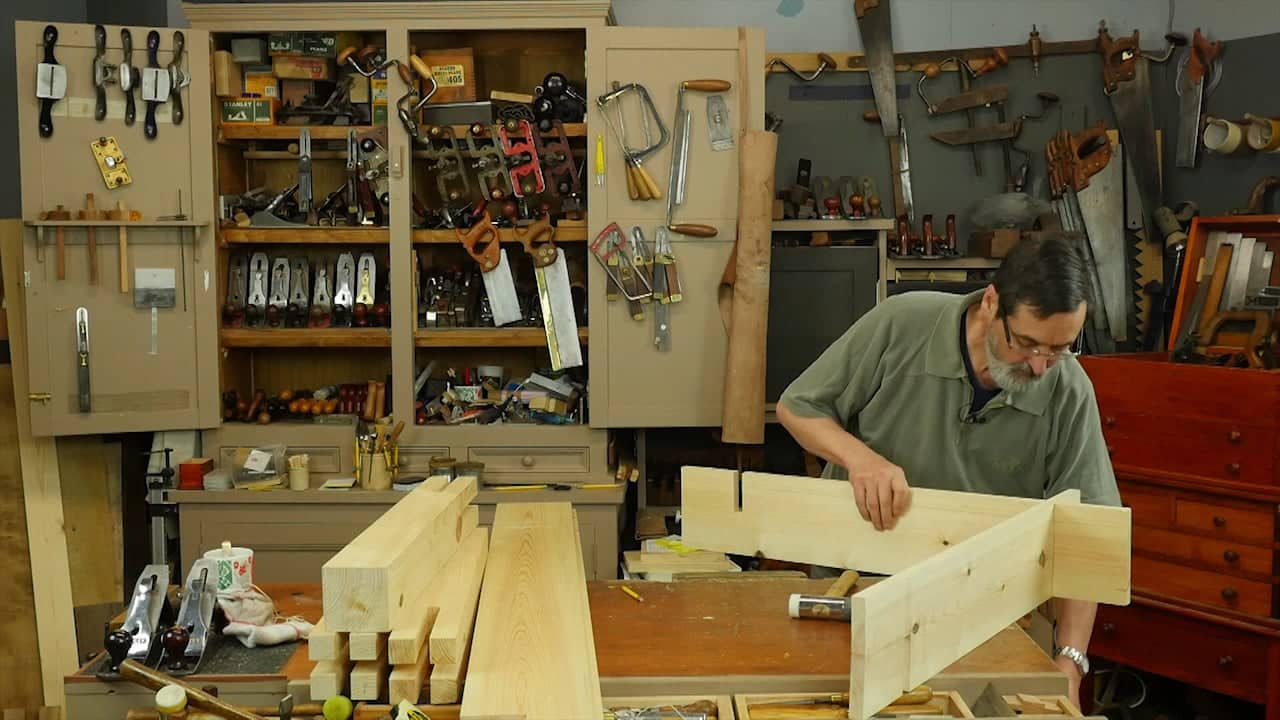Assembly Table – episode 1
Posted 21 October 2015
This is an episode in a paid series. Want to watch it? You just need to sign up as a paid member, and you can enjoy this video and many other videos we think you will love.
In this episode Paul introduces a new project that has a really unique and diversely applicable. This project will be useful around the shop and could be adapted to a whole host of other uses.


Is it Christmas? Thanks for all these great extra videos you’ve been making for us lately.
Interesting, you can kinda date the episode from the contents of the background. Anyone else notice the frame saws, and the wood from the dining table project? 😛
The rails would be 1″x8″ (nominal) in the U.S. But we do have 4″x4″ stock readily available, though it’s hard to find them not pressure treated (anti-rot).
Super useful joint, with many applications. If inverted guess it could be used for holding up a post such as for a lectern or similar. Great table too as well as all these other knowledge & technique building aspects. Thank you!
A bery useful joint. I can see little table projects popping up in my head already. 🙂
once again a perfectly timed video I was thinking only last night “I must email Paul and ask him is there any chance of an assembly table video” after seeing it in the upholstery videos, see great minds do think alike (nobody finish that saying please), Thanks
Am I right in thinking this was leather covered and on casters for the upholstery episodes, or is that something else?
Hello Anthony.
Those assembly tables are different in that they have the aprons tenoned into the legs in the more conventional way and glued.
Best,
Phil
Thanks Philip.
Thank you for the lesson.
Anyone know what the TPI and length of the rip saw is?
From the Saw Sharpening video comments, Paul wrote:
“For my handsaws I stay around 8-10 tpi but use a 6 tpi rip too.”
I would think that for ripping the posts he would use a 6 tpi.
Perfect timing, I recently started at a new shop & was told to make myself a table to keep parts on. Thank you
Nice video, intersting joint. This one would be handy for my neighbour she has twelve guests for Christmas dinner. Thank you Paul.
Thank you for demonstrating another useful joint. Any thoughts on using laminated legs? On the workbench you use 2 x 4s but have the mortise to pass through the lamination…
Hi,
This is my first post as a full member (Although I’ve followed you on Ytube and ‘hoovered’ up your free content).
You of course, have no problem setting a gauge, I was shown (In School 30yrs ago) to not quite cinch up the tightening screw and to ‘tap it In’ – gentle knocks on either end of the beam to get the exact setting, then to fully tighten. Rather than to fiddle around chasing errors.
I can see that this will eventually leave one with a sloppy gauge (as is found on Ebay) but does this technique have it’s place in learning or should it be avoided as a bad habit?
(apologies if this has already been covered)
Hello Steve,
Tapping to adjust gauges is our standard way of working and shouldn’t cause problems, especially not if done by you on your own gauges. I think that the reason some of the old/ebay gauges are sloppy are form the wood shrinkage or very heavy use. Sometimes you get a sticky gauge that needs fettling to get it to move. When adjusting those it can very tempting to take too much off and end up with a loose gauge, although they generally still tighten up OK.
Hope that helps,
Phil
Ah nice one – I used the same joint as your 1x8s to build a knock down sandpit for my son with pressure treated timber, although I had a fair amount more movement within the joints. First time seeing that joint with a leg combined though.
I’m new to this forum but have watched numerous You Tube videos of Paul and his work.
I am a little curious why in this video the boards/material was “machined” vs planing. I sort of thought this was going to be building using most of the hand tools, ie, chisel, hand saws, planes etc available to most. I do not have access to jointers or planers.
This won’t stop me from watching as there are many techniques I am picking up to improve my skills but was really hoping for videos that were “100% hand tools”.